Recent Fire Damage Posts
3 Things To Know About Fire and Your Electronics
6/25/2022 (Permalink)
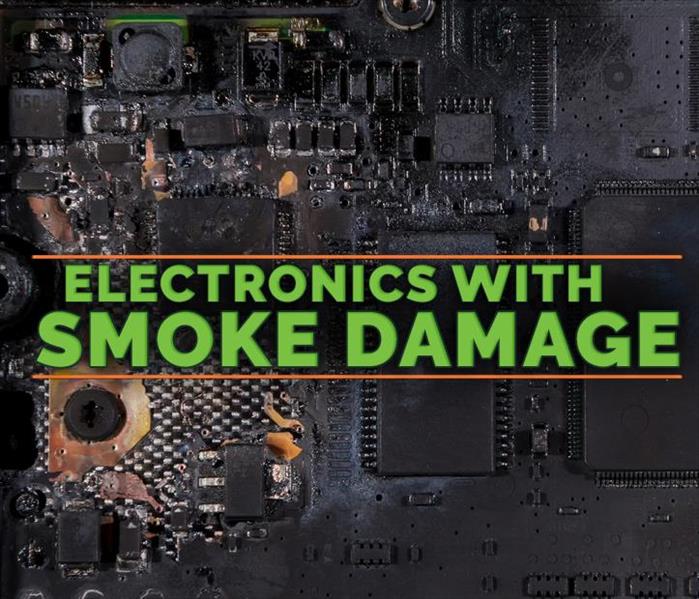 How does smoke damage electronics?
How does smoke damage electronics?
Three Things To Keep In Mind When It Comes To Fire And Your Electronics
After a fire at your home or commercial building, much of the damage will be obvious to the naked eye. Smoke damage can discolor walls and leave telltale odors in fabrics. Fire can singe cabinets and destroy drywall. What about your electronics, though? Should they be part of the fire cleanup? Read on to learn more about fire damage and your electronics.
1. Gear That Looks Fine On the Outside May Still Need Fire Cleanup
Sometimes, electronics wear their fire damage front and center. Other times, a gaming console or personal computer that looks A-OK on the outside contains interior damage. When you contact your local fire damage restoration company, ask them about the electronics cleaning services they provide.
2. Virtually No Electronics Are Smokeproof
Most of the electronics in your home are made mainly of plastic and metal. The high heat given off by a household fire can melt both, but that's just the tip of the rapidly melting iceberg when it comes to fire's effects on your electronics. Here's what else can happen:
Electronics melt and become inoperable.
Interior components melt, but you can't see it, and they continue giving off toxic fumes.
Failing electronics short circuit and cause a fire.
Soot and smoke residue traps heat like insulation and causes electronics to overheat and fail.
Soot corrodes the unit from the inside out, abbreviating its life or causing it to short circuit.
3. You Shouldn't Turn Your Tech Back On Right Away
Until you determine the extent of the damage after a fire at your Oak Tree Village, TX, home, resist the urge to fire up your electronics (no pun intended). Some of the damage outlined above can happen instantly and develop into an even more significant problem.
Even the most modern, high-tech gear is vulnerable to good old-fashioned smoke. Including your electronics in the fire cleanup effort can help prevent costly repairs, or even replacement, in the not-so-distant future.
Is Your Company Prepared for Fire?
5/24/2022 (Permalink)
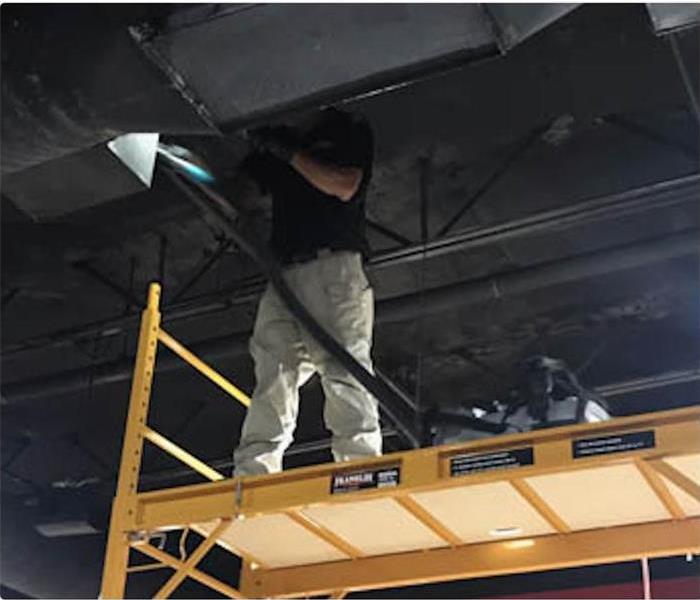 Experts in fire cleanup and restoration in Vickery Meadows, TX.
Experts in fire cleanup and restoration in Vickery Meadows, TX.
Is Your Company Fire-Resistant?
Fires at nonresidential buildings can be caused by cooking, accidents or electrical malfunctions. Prioritizing fire preparedness is the best way to reduce the risk of extensive fire damage to a commercial structure in Vickery Meadows, TX. Find out more about the importance of developing a contingency plan and evacuation plan and making sure that a facility is equipped with functional fire safety systems.
A Fire Can Start At Any Time
While an electrical fire can start at any time, fires in commercial properties tend to occur on business days when structures are at full occupation. Here are a few commercial fire timing facts:
- Most fires at office properties occur between noon and 2 PM.
- Less than one-third of commercial fires occur between 7 PM and 7 AM.
- Commercial fires are less common on weekends.
Fires that occur outside of working hours and days tend to cause more damage. Investing in quality fire suppression systems can go a long way toward limiting the extent of fire damage restoration required.
Your Company Needs a Contingency Plan
Making fire safety preparations is the best way to reduce fire risk at peak times. A commercial property owner or manager should also have a plan for worst-case scenarios in place that covers a building evacuation, and regular fire drills and delegates the responsibility to account for every occupant of a structure.
Fire Prevention and Preparation
Fire prevention can reduce the risk of preventable fires, but commercial property owners and managers should also prepare for fires that are harder to prevent. A contingency plan involves planning for the worst even while you hope for the best. Fire prevention practices can reduce the risk that ablaze will break out or become a fire capable of causing significant damage to a commercial building and surrounding property in Vickery Meadows, TX.
How To Clean Smoke-Damaged Contents
3/13/2022 (Permalink)
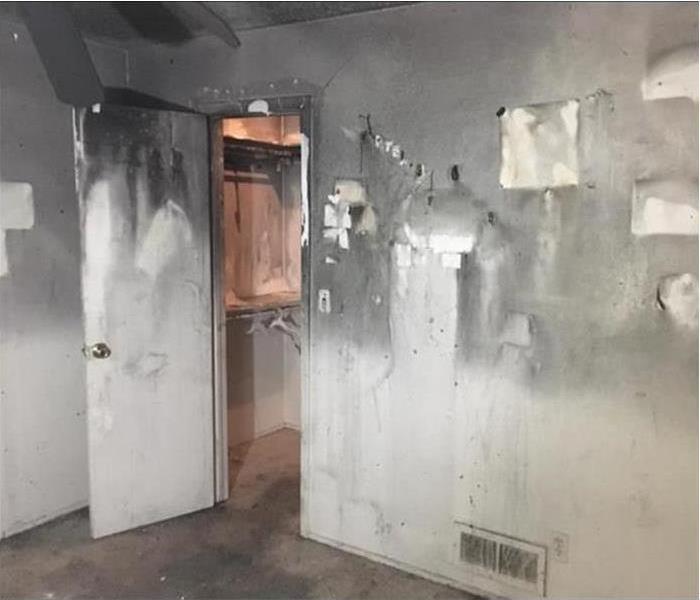 Fire damage in Oak Tree Village, TX.
Fire damage in Oak Tree Village, TX.
Methods To Clean Smoke -Damaged Items
There is so much to do in the aftermath of a fire in Oak Tree Village, TX. From water damage to fire and smoke damage, there may be significant cleaning and restoration work to do inside the affected building. Contents inside the property may be just as damaged as the building structure itself. Can contents be effectively cleaned? Is dry cleaning an option? You may also need to consider content storage following item removal and cleaning. Below are several methods that may be used to clean smoke-damaged items following a fire.
1. Wet Cleaning
Many items inside your building may withstand cleaning via water-based methods. Dishes and some keepsakes are examples of items that may be wet-cleaned.
2. Spray and Wipe
Cleaning of contents that cannot handle thorough wetting may include spray and wipe cleaning methods. As the name implies, cleaning material is sprayed directly onto items and then wiped until clean.
3. Dry Cleaning
This method may be a great way to restore fabric-based items such as clothing, bedding and window curtains. Specialized cleaning treatments may help remove lingering smoke odors and stains.
4. Foam Cleaning
Foam cleaning may be a good choice for certain upholstered items that may not be cleaned with water. Cleaning foams are specially designed to remove smoke damage and resulting odors.
5. Abrasive Cleaning
This content cleaning method involves using fine particles on an item’s surface to remove smoke damage. Abrasive cleaning methods may be used on building contents or on the property itself.
6. Immersion Cleaning
This technique involves submerging contents into a cleaning solution to remove stains and odors.
There are many ways that your building contents can be cleaned and restored following a fire. Cleaning methods may depend on many factors, including the extent of the damage and the type of materials that need cleaning. A professional fire damage assessment may help identify the required cleaning methods for your contents. Dry cleaning, wet cleaning and several other options are available to help restore the contents of your building.
3 Things To Know About Lightning and House Fires
2/23/2022 (Permalink)
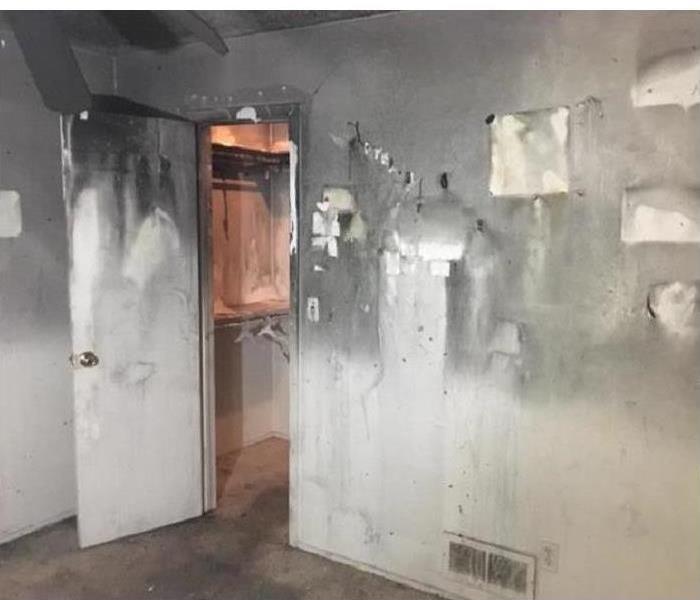 Residential fire damage in Hamilton Park, TX.
Residential fire damage in Hamilton Park, TX.
3 Things To Keep In Mind When It Comes To Lightning And House Fires
A lightning fire can occur quickly and can devastate your home in Hamilton Park, TX. There are many misconceptions about these types of fire, however, and learning more about these types of fires can help you feel more prepared to react in the event of a fire.
1. Damage to Your Home Is More Likely Than Injury
When lightning strikes, a house fire is often the result; it is relatively uncommon for a person to be struck. In the United States, fewer than 60 people were injured by strikes in four years. However, a significant amount of damage was done to homes in that time period due to fires that occurred as a result of a strike. Unplugging appliances in your home can help to reduce the likelihood of your home being struck.
2. The Time of Year and Environment Matters
In general, a lightning fire is more likely to occur during the summer when storms occur. Additionally, certain environments are more susceptible to fires that are caused by lightning. Areas that are experiencing drought are more likely to see these types of fires since dry grasses and shrubbery can quickly ignite and spread, which can result in extensive damage to the area.
3. Preparation and Education Can Be Useful
If you are outside when a storm begins, there are steps you can take to that can help keep you safe. Keeping away from water and keeping your distance from tall trees and powerlines can reduce the likelihood of being struck. If you are inside when a storm occurs, keeping away from windows can also be beneficial. Additionally, knowing how to react if any type of fire occurs in your home can help to keep you and others safe.
Understanding the damage a lightning fire can cause, knowing when this type of fire is likely to occur and knowing how to react during a storm can help you take steps to protect yourself. If your home has been affected by this type of fire, it can be useful to contact fire and storm restoration experts.
4 Facts About Fire Damage Coverage
12/16/2021 (Permalink)
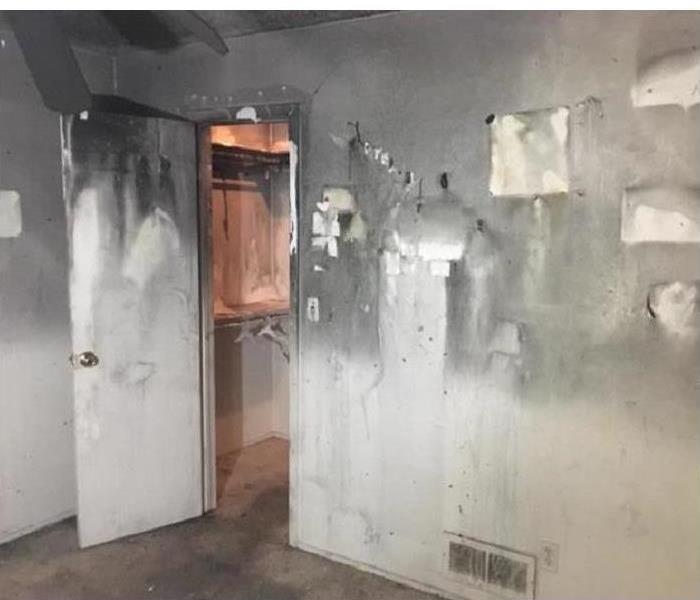 Fire damage in a Lochwood, TX home.
Fire damage in a Lochwood, TX home.
Fire Damage Coverage
Fire damage is a covered peril under most insurance policies. If you lease a portion of a building for residential or commercial purposes in Lochwood, TX, it is important to know how much liability coverage you have, and its limits.
1. "Fire Legal" Is Equivalent To "Damages To Premises Rented To You"
"Fire legal" was the term used to describe liability coverage in the 1986 commercial general policy. In 1998, this portion of a commercial policy became known as "damages to premises rented to you." Liability coverage applies if the named insured causes a fire, and is usually an exception to policy exclusions.
2. A Lease Contract Can Cancel Out Liability Coverage
Liability coverage will not apply if a lease agreement states that a tenant accepts full responsibility for fire damage. This is called contractual liability, and a modification of lease terms will be necessary to restore coverage.
3. Limits Should Correspond To a Policyholder's Stake
The limits of liability coverage should reflect the value of the portion of a structure in the care, custody, and control of the named insured. If it does not, the tenant is underinsured. Limits on these policies are usually $100,000 or less, but can be increased.
4. This Coverage Only Applies to Fires Caused by the Policyholder
Fire liability coverage only applies to fires for which the named insured is at fault. This coverage does not apply to other types of damage or no-fault fires. Other types of coverage are needed to offset these damages and the cost of fire damage restoration.
Policyholders should be aware of the extent and implications of their insurance coverage. Tenants should consult with an insurance agent or risk advisor to ensure that they have a sufficient amount of liability coverage for fire damage and smoke damage to the portion of a structure in their care, custody, and control.
Tips for Using a Fire Extinguisher
10/22/2021 (Permalink)
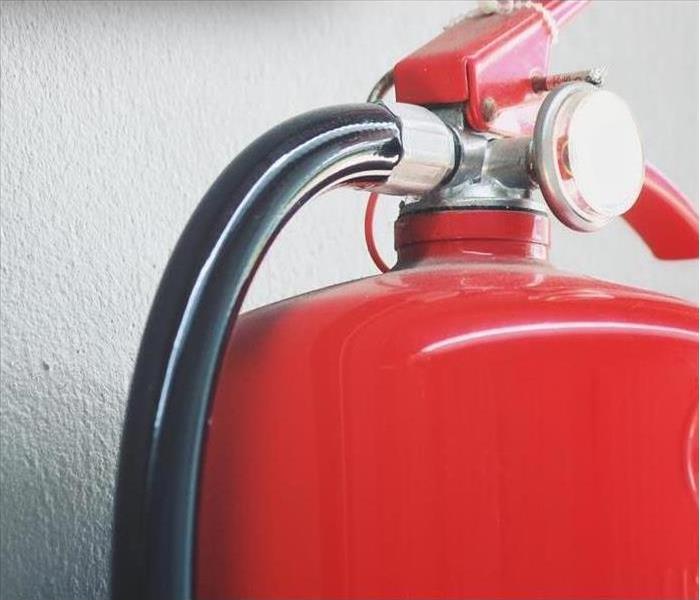 Make sure you have the right type of fire extinguisher.
Make sure you have the right type of fire extinguisher.
How to Use a Fire Extinguisher
As a homeowner in Wilshire Heights, TX, you need to be prepared for emergencies. If you've ever had a house fire and had to call in professionals to restore your home, you understand the importance of having a fire extinguisher on hand. Following the steps below can ensure that you're using it correctly.
1. Assess the Situation
First, understand what you're dealing with. If the blaze is already too big, the best idea may be to call the fire department and get yourself and anyone else in the house to safety. If you can safely douse it with a fire extinguisher, you need to next make sure that you have the right type for whatever material is burning.
2. Use the Right Extinguisher for the Fire
Experts classify extinguishers based on the type of fire they can combat. These include:
- Type A: for fires involving plastics, wood, textiles and paper
- Type B: used on fires involving solvents, gasoline, oils, paints and other flammable liquids
- Type C: for electrical fires, including plugged-in equipment like computers or appliances
- Type D: for fires involving combustible powders or metals
- Type E: commonly used for a kitchen fire involving fats or cooking oils
These letter classifications are always found on the sides of the extinguishers, many of which are rated for putting out fires of more than one type.
3. Remember: "PASS"
The PASS method is an easy way to remember how to use most fire extinguishers. Each letter in "PASS" stands for the first word of an operational step. The "P" tells you to pull the pin at the top of the extinguisher; it needs to be removed before operation. The "A" tells you to aim the nozzle. The nozzle should not be aimed at the top of the flames, but at the bottom, where the combustion is taking place. The first "S" tells you to squeeze the handle to start the flow, and the second one reminds you to sweep from side to side while spraying.
By acting quickly and following the instructions above, you can safely prevent fire damage before it has a chance.
Effective Ways to Get Rid of Dryer Lint
7/29/2021 (Permalink)
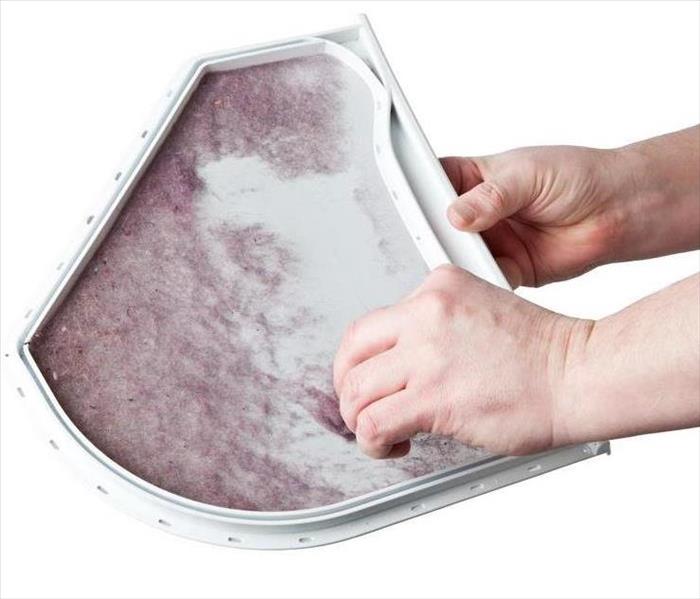 Cleaning your dryer on a regular basis is crucial for your safety.
Cleaning your dryer on a regular basis is crucial for your safety.
How To Remove Dryer Lint Effectively
Excess dryer lint: It’s a problem just about everyone deals with, but it can be much more serious than you may think. Over time, your dryer will collect lint from your apparel as well as towels, blankets and anything else you wash and dry. If you neglect to dispose of these materials and clean out the dryer exhaust, a lint fire could result in your Tree Village,TX home. The consequences of this could be disastrous. Fortunately, there are some basic ways you can handle this situation and avoid catastrophe.
Clean the Screen
The simplest ways to clean lint from your dryer and stave off the risk of a dryer fire is to clean the lint screen. Depending on the type of dryer you have, you can find this at the top of your dryer or even inside the door or on the side.
- Gently pull out the screen; do not bend.
- Run your hands across the screen and collect the lint; discard it.
- Vacuum the surface of the screen.
- Rinse the screen with water.
Clean Inside the Trap
Often, cleaning off the screen isn’t enough to avoid the risk of fire damage. It’s a good idea to regularly clean out the trap as well. It’s easy for lint to get trapped in this area, so take a vacuum and suction out any remaining debris. Make sure you get your vacuum hose and attachment as far down the trap as possible.
Clean the Exhaust Hose
Another important way to reduce the risk of a lint fire is to unplug your dryer and remove the exhaust hose. You can then vacuum inside the hose or use a long brush to remove lint that may be stuck far inside. Make sure when you put the hose back on that it’s secure.
If you follow these steps, you can help ensure you won’t have a lint fire in your Tree Village, TX home. Cleaning your dryer regularly is an essential way to stay safe.
The Smoke Cleanup Process
7/13/2021 (Permalink)
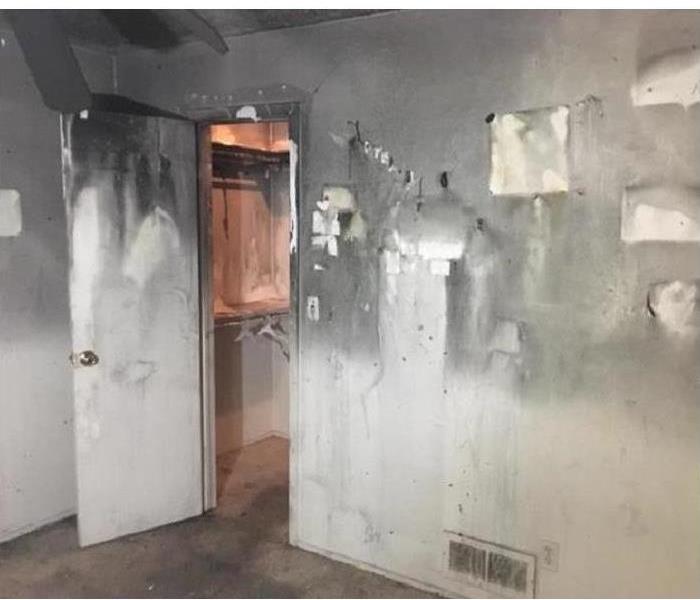 Soot after fire damage.
Soot after fire damage.
The Smoke Cleanup Process
Few smells linger like the odor of smoke. Even if a fire in your home in Oak Tree Village, TX, only affects part of the structure, smoke damage can permeate the entire house. Fire remediation experts remove smoke and soot after they have secured the area and extracted anything damaged by the fire and the water used to put it out. They may use several techniques to do so.
Dry Cleaning
Regular washing may not get rid of the total smell left behind by smoke. Many of the items that need odor removal can be handled by dry cleaning:
- Draperies
- Clothes
- Furniture covers
- Linens
When you wash smoke-infused clothing in a washer, there is an extended period of time where the clothes are sitting in smoky water. The smell can also get trapped in the machine itself. Dry cleaners often have special oxidation processes for getting soot damage out of textiles.
Thermal Foggers
Many professionals use industrial foggers to rid homes of smoke damage after a fire. A fogger is helpful because it gets the smoke out of cracks and crevices in a similar way to the process it underwent during the fire. Chemicals are heated to produce fog that permeates porous surfaces, traps smoke particles and neutralizes them. Once the fogger has completed its job, the air is usually noticeably cleaner.
Ozone Treatments
Another smoke cleaning method is the use of ozone machines. These devices create a similar atmosphere to the outside air after a thunderstorm. By releasing ozone particles into the air, the area gets refreshed. Soon, the clean air replaces the sooty, stale air, making your home smell clean and normal again.
A fire in your home will likely cause extensive smoke damage not only to items within your home but to the structure itself. Professional technicians can clean the damaged area and employ various methods to get rid of the smoke odors.
3 Surprising Things You Can Do To Prevent Space Heater Fires
7/7/2021 (Permalink)
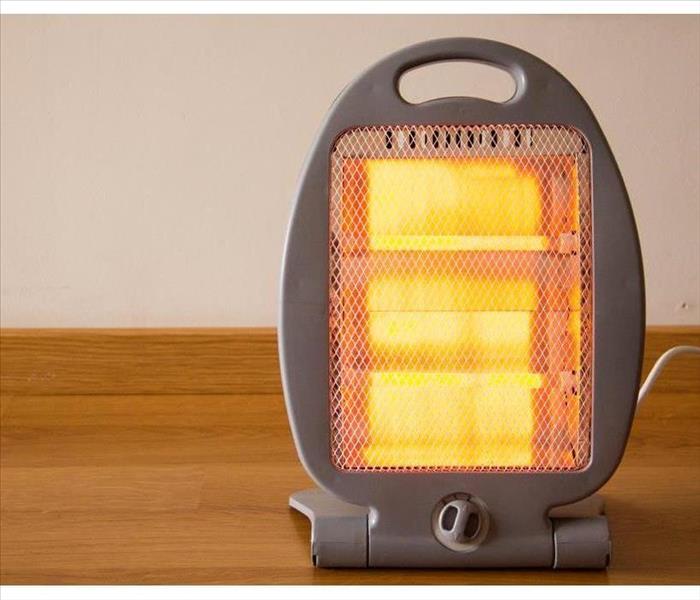 If you rely on a space heater for warmth, follow these helpful tips.
If you rely on a space heater for warmth, follow these helpful tips.
Did you know that space heaters are estimated to cause over 25,000 residential fires each year? If you rely on a space heater to warm your home or office in Dallas, TX this number can be alarming. Fortunately, you are not helpless and can minimize your chances of dealing with a burned space heater. Here are three surprising things you can do to prevent space heater fires in your living space.
Space Heater Fire in Dallas
1. Keep Filters Clean
Have you ever cleaned the filters in your space heater? If not, your heater is at greater risk of catching on fire. Dirt and debris collect on the filters over time and can cause the space heater to overheat and ignite. To keep this from happening, clean your filters regularly (preferably before each use).
2. Turn Your Heater Off Regularly
Many homeowners use space heaters just like furnaces to keep specific rooms in their homes warm during the colder months. However, a space heater is designed for only temporary use and can easily overheat if left on indefinitely. To reduce your chances of dealing with a burned space heater (or burned home!) remember to turn your heater off regularly.
3. Never Leave Your Heater Unattended
Life gets busy, and it’s easy to forget you have a space heater running in the other room. For this reason, it’s strongly recommended that you never leave your heater unattended by an adult. You should also place it on a hard, stable surface that’s far away from carpets, fabric and other flammable items. Your heater should have at least 3 feet of space all around it whenever it is operating. You should also keep it away from children and pets that could knock it over and get burned by it.
If you rely on a space heater for warmth, follow these helpful tips to avoid dealing with a burned space heater or home fire. If your space heater does overheat, know the number of your local fire restoration experts in Dallas, TX. They can help with your fire damage and smoke cleanup efforts.
3 Tips for Preventing a Space Heater Fire
3/18/2021 (Permalink)
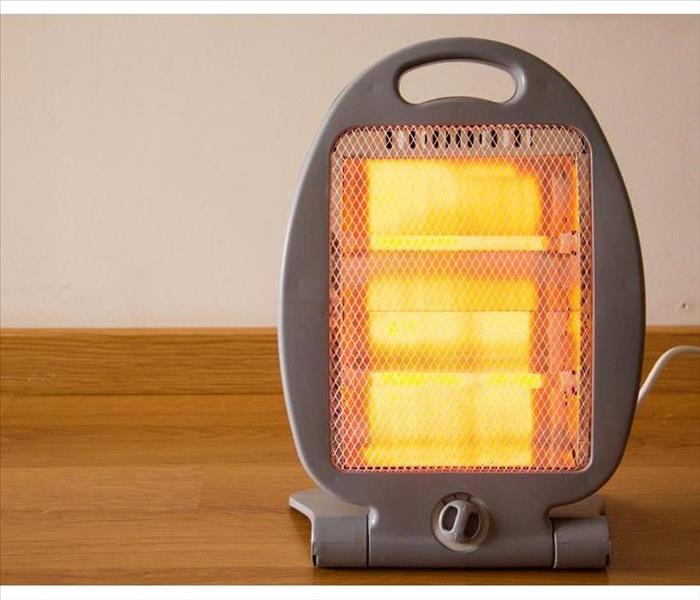 Do you have a space heater in your home?
Do you have a space heater in your home?
3 Tips for Preventing a Space Heater Fire
Does your home in Lochwood, TX, have a space heater? Being responsible for more than 40% of heater fires, a burned space heater is a common culprit that many fire cleanup specialists see often. There are many easy ways to stay safe with one of these fixtures in your home.
1. Leave Space
It's called a space heater because it's designed to heat space, not your curtains. In addition to keeping your heater away from any fabrics or other flammables, be sure to inform your children about the dangers of leaving objects near them. Plastic toys melt if left close by a heater for a long time. If you have pets, take steps to ensure that they won't knock over the heater or otherwise harm themselves accidentally.
2. Keep It Clean
Another common cause of a burned space heater is a clogged filter. Though not all units come with one, it's important to clean it regularly if yours does. Different cleaning measures are recommended based on the manufacturer's instructions. If you lost your manual, check online for a pdf of it or look on your unit for a phone number to call. No matter what, be sure that you never clean your filter with any type of alcohol or scented aerosol spray as both are extremely flammable. The smoke cleanup from that is a hassle that you don't want to deal with.
3. Set a Timer
We all forget things every once in a while, but it's important that you don't forget to turn off your space heater. While some units come with a timer, most don't. If yours doesn't, try setting a timer on your phone, microwave, or oven. Additionally, if your home has a smart assistant, consider using wall plug accessories to automatically shut off your unit.
With some knowledge, it's certain that your home won't be affected by a burned space heater anytime soon.
What Is Content Cleaning?
12/18/2020 (Permalink)
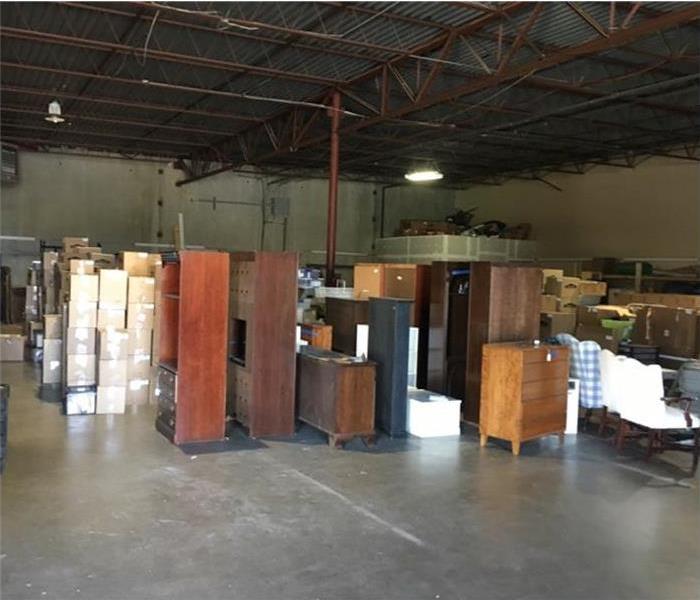 A content cleaning team in your area can assess the salvageability of your contents
A content cleaning team in your area can assess the salvageability of your contents
Clothing and other items that have been damaged, but not destroyed, due to a fire can sometimes be restored by dry-cleaning and other methods to remove soot and smoke smells. This process is called content cleaning.
What Types of Contents Can Be Cleaned?
Contents are classified as either hard or soft. Soft contents include items made from fabric and other soft materials:
- Clothing
- Leather goods
- Bedding
- Uniforms
- Heirlooms
Hard contents include items such as furniture, electronics, collectibles, sports equipment and antiques. Whether the item is hard or soft and what type of material is its made from affects the cleaning method utilized.
Cleaning Methods
Content restoration professionals use different types of cleaning methods for different types of contents. Dry-cleaning is often used to remove light residues or pre-clean clothing. Wet cleaning can be used to remove heavy residues. Spray and wipe methods are used on items that may be damaged by wet cleaning. Foam cleaning is used for upholstery fabrics. Abrasive cleaning is used on some hard surfaces and immersion cleaning is used for contents that can be submerged in cleaning products.
Contents Analysis
After you contact a fire restoration company in Lochwood, TX, to perform content cleaning, a team member will examine your property and determine which items are salvageable. Unsalvageable items need to be replaced.
Pack Up, Pack Out and Pack Back
If extensive restoration is needed, the restoration company can pack up and move your damaged items to their facility for cleaning. The items are then packed out and cleaned. The clean items are kept in content storage until they are ready to be packed back and delivered to the homeowner.
Dry-cleaning and other cleaning methods can be used by fire restoration professionals to restore some items damaged by fires. A content cleaning team in your area can assess the salvageability of your contents and save you money by restoring some items that would otherwise need to be replaced.
4 Things Business Owners Should Do After a Fire
10/26/2020 (Permalink)
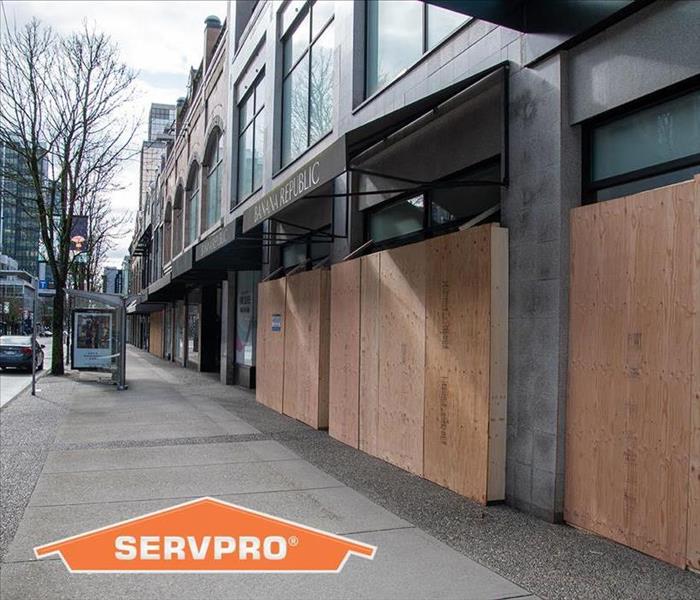 Board up services in Vickery Meadows, TX
Board up services in Vickery Meadows, TX
To Get Things Started, Owners Should Complete The Following Four Steps
Business owners in Vickery Meadows, TX, face several obstacles after a blaze. The property has become a hazard with limited access, operations have halted and remediation must begin. It's an overwhelming situation. There is no downtime to dwell on these concerns. Fire restoration should begin as soon as possible.
1. Speak With Your Insurer
Initiate a fire insurance claim. Call your agent immediately, discussing the details of the conflagration. Be clear about the time, date and circumstances. If the fire department provided you with contact information, be prepared to give the agent that as well. During the conversation, ask about your deductible, total coverage and any procedures they may require. When finished, write down conversation notes, and keep it on file for reference.
2. Board Up the Premises
Fire restoration companies can assist you in securing the building. The flamed destroyed various sections, creating openings in the walls and ceilings. On top of that, the fire crew may have busted open windows to increase ventilation. These gaps must be secured in order to safeguard valuables. Left alone, rain, animals and vandals would have access to your store.
3. Begin Cleanup Assessments
Have experts evaluate the amount of smoke cleaning required. The specialists should come in and inspect the rooms, determining how much has been harmed. Provide this report to insurance. Expect the insurer to send out their own inspector or adjuster as well to confirm the conditions.
4. Make a List of Concerns and Losses
With proper gear and the permission of work crews, walk around the facility. Note anything that has been impacted. Take photos of the scene, especially fixtures, electronics and assets that demand cleaning or replacement. Save the images, and email them to your agent.
These initial actions aid in expediting the remediation efforts. Be proactive. Remain in contact with your insurance agent. Fire restoration professionals can tend to security concerns and cleanup endeavors.
3 Important Things Every Fire Escape Plan Needs
9/17/2020 (Permalink)
 Prepare a fires escape plan for your home
Prepare a fires escape plan for your home
Preparing Your Home From A Fire
Most people understand the basics of a fire escape plan, such as knowing how to get out of the home quickly, where to meet, and what to do if your clothes catch on fire. However, there are some important elements that may not immediately come to mind when you are preparing for the chance of a home fire in Oak Highlands, TX.
Windows Are Exit Routes, Too
While most homes have multiple exterior doors that could be used in the event of an emergency, knowing how to exit through a window can be essential. Keep in mind that some rooms may be on an upper floor, thus presenting additional challenges to anyone trying to escape. Think through every step it would require to get out of those windows, and make sure your fire preparation plan includes any tools or items that will aid in an escape.
Emergency Contact Numbers Should be Memorized
The moment you actually need to use your fire escape plan is the moment you have to get out as quickly as possible. It may not be feasible to assume that you'll have time to grab personal belongings before you go, so counting on your phone for contact information may not be the best idea. Instead, work with your family members to memorize important phone numbers, such as:
- 9-1-1
- A neighbor and friend they can trust
- A family member who lives nearby
Know Who Can Help in the Cleanup Process
Dealing with the aftermath of an emergency can be overwhelming, to say the least. Do your homework in advance to know what kind of damage cleanup services may be available to you in the event of a fire. Keep this information, along with your insurance contact and policy number, in a place where it can be accessed safely and quickly when it comes time to file a claim.
Thinking of every angle can be difficult when putting together a solid fire escape plan, but doing so is essential. By adding these three important items to your emergence preparation process, you will be even more ready if the need arises.
How do I keep my home safe after fire damage?
7/15/2020 (Permalink)
The term "board-up" may have been thrown around a few times by the insurance company and adjuster. You may have even heard it said by the firefighters. The term relates to securing your home after it has been damaged by fire.
Covering the Openings to your Home
Your home will have windows, doors, and even parts of the roof missing after a fire damage. The openings are usually manmade by the firefighters to help them ventilate the house while they fight to extinguish the flames. However, once the fire is out your home is open to the elements and looters. If you home is uninhabitable you need to have the services of SERVPRO of Northeast Dallas. We will secure your home using plywood and roof tarps. The security of your home is a vital part of mitigating the damage done by the blaze.
3 Ways You Can Prepare Your Business for a Potential Fire
7/15/2020 (Permalink)
Ways You Can Prepare Your Company to Prevent a Potential Disaster
Your company should always be prepared for a potential business fire. A fire can cause severe damage to the structure of the building, expensive equipment, and business materials, and it can also put you and your staff in harm’s way. Thee good news is that there are numerous ways you can prepare your company to prevent a potential disaster.
1. Inspect the Fire Extinguishers
A key way to prevent damage from fire in Wilshire Heights, TX, is to regularly inspect all of the fire extinguishers. They should all be up to date. If this is not the case, it is best to have a professional come out and perform an inspection to make sure they are working properly. The extinguishers should also be mounted on the wall correctly, and there should be one placed on every floor.
2. Train Employees in Fire Safety
One way to avoid fire damage is to train your employees on business fire safety, so they are educated on what should be done if a fire occurs. Have a plan or drill that takes place often, so everyone is on the same page when it comes to workplace fire safety protocol. Designate a safety officer who will be in charge of creating escape routes and meeting points.
3. Keep Exit Doors in Check
It is important to have plenty of exit doors in the building, giving people numerous chances to get out safely if a fire occurs. It is also wise to make sure these doors are unlocked at all times and have enough lighting around them for employees to make a quick escape if the building or room is dark at the time of a fire. This is a key step when it comes to fire preparation.
Keep these tips in mind so you can increase the safety of your company and employees. In the even that a business fire does occur, it's wise to contact fire damage specialists that can assess, repair, and restore your property promptly.
Salvaging Smoke Damaged Items Through Cleaning
7/2/2020 (Permalink)
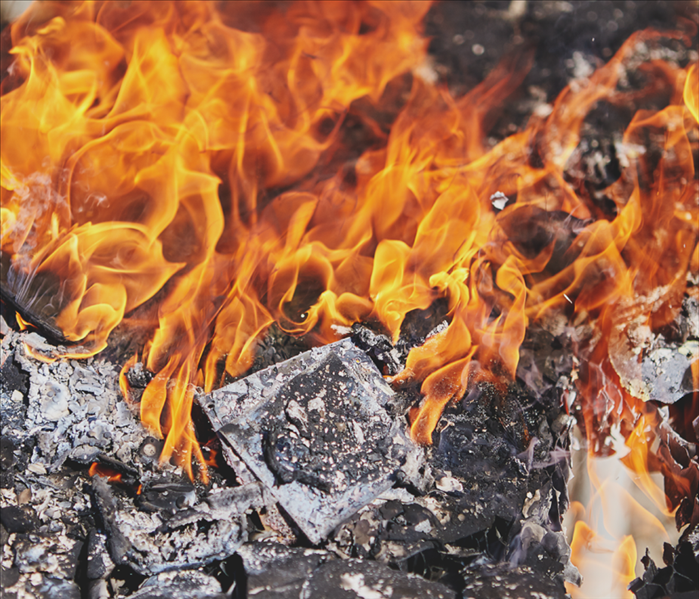 Burned content in Northeast Dallas, TX
Burned content in Northeast Dallas, TX
Having an insurance policy that covers fire damage to your property is one part of responsible commercial property ownership. Working with a qualified fire restoration service provider is another. If you ever experience a property fire in Northeast Dallas, TX, an expert in fire restoration knows and understands the best methods of content cleaning to quickly bring your property back to pre-fire conditions. From dry-cleaning to smoke odor removal, your professional restoration provider has the training and equipment to minimize the interruption to your operations.
Understanding Restoration vs Replacement
You may think that a fire restoration process automatically means replacement of damaged content. On the contrary, the right professional provider looks for every opportunity to salvage items through cleaning before considering replacement. This includes testing items to see which ones can be returned to a pre-fire condition. Common cleaning methods include the following:
- Dry-cleaning. Appropriate for light residues or as a pre-clean to wet cleaning
- Wet cleaning. Best for moderate to heavy soil.
- Spray and Wipe. Used for objects that can’t be wet cleaned.
- Foam cleaning. Best for upholstery fabrics that may shrink or be otherwise damaged by wet cleaning.
- Abrasive cleaning. Refers to wiping surfaces through agitation and friction.
- Immersion cleaning. Involves dipping objects into a bath for cleansing.
Even electronic devices that have been damaged by fire may be saved through a cleaning process. Fire restoration providers have the knowledge and equipment to thoroughly inspect electronics for repair and safe operation.
Letting the Pros Handle the Cleanup Process
The fire repair process requires consideration on several levels. In addition to fire and water cleanup and dry-cleaning, other services may be necessary including content storage to protect items from further damage. Your fire restoration pro can coordinate any move-out or pack-out work necessary to get your property back to a pre-fire state. Trust the pros to understand what is needed to get things back to normal.
4 Tips For Preventing a Fire in Your Home
6/18/2020 (Permalink)
 Install smoke alarms in every sleeping room of your home
Install smoke alarms in every sleeping room of your home
4 Tips For Preventing a Fire in Your Home
No one likes to think about the possibility of having a fire in their home. Fires can be devastating physically, emotionally, and financially. Fortunately, there are ways you can prevent the likelihood of a home fire. Here are four tips for preventing a fire in your home.
1. Install Smoke Alarms
Fire preparation begins with installing smoke alarms in every sleeping room of your home. You should also have smoke alarms placed in hallways, kitchens, and family rooms. Once you’ve ensured you have the right number of alarms, be sure to test them monthly and replace batteries annually.
2. Educate
Education is key to increasing the safety of your loved ones. Teach children the following fire safety basics:
- Stop, drop and roll
- Fire crawl
- Checking doors for heat
- Escape routes
- The location and sound of smoke alarms
- Emergency phone numbers
3. Create an Escape Plan
Everyone should create a fire escape plan. Creating a plan is one of the best fire preparation tips to keep your family safe. Draw a floor plan of your house and mark all possible exits, including doors and windows, in each room. Walkthrough your home and ensure that exits are free from clutter and that children know how to open and safely exit each window.
4. Practice Your Plan
Once you have a plan in place, it’s wise to practice it. Choose at least two times a year to hold fire drills. These drills can either be planned or spontaneous. A good run-through of the plan will identify any areas that need to be adjusted or improved. Remember to emphasize that once you get outside, you should stay outside. Never go back inside a home that is on fire.
Fire preparation is one of the best things you can do to keep your kids safe in the event of a fire. If you ever experience a fire in your Oak Highlands, TX, home, there are restoration specialists that can help restore your home.
How to Put Out a Grease Fire
2/24/2020 (Permalink)
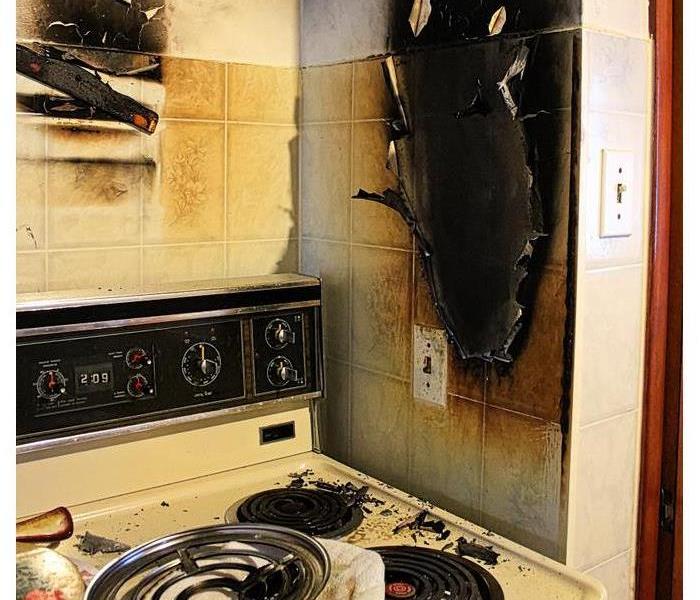 A kitchen grease fire in Lochwood, TX
A kitchen grease fire in Lochwood, TX
How to Put Out a Grease Fire
A grease fire is pretty much the worst accident that could happen in a kitchen. In fact, it is one of the leading causes of house fires, claiming over 3 000 homes in Lochwood, TX each year. That's why you need to know how to stop this potential disaster before it spirals out of control.
Here are some of the things you should never do when dealing with a grease fire:
- Do not pour water on the fire
- Do not attempt to move the pot
- Do not use any other baking product beside baking soda
Turn Off the Heat
Turn off the heat as the first thing you do when the oil starts to smoke. If there's a flame already, cover the pot with a metal lid to starve the fire of oxygen. However, it is worth noting that this procedure works if you spot the flame before it gets out of control. It's the main reason why fire experts advise people to stay in the kitchen while cooking.
Pour Baking Soda
Baking Soda can put out small fires, but you have to use a lot of it. The good thing is, this baking agent will not cause any contamination, even when it falls on foodstuffs. Alternatively, use a generous amount of salt to put out the blaze.
Use a Chemical Fire Extinguisher
When everything else fails, use a chemical fire extinguisher to put out the oil fire. You need to be extra cautious as the extinguisher's pressure might spread the burning grease all over the kitchen. Its contents will also contaminate everything it comes into contact with, and a fire cleanup is the only way to undo its effect.
Although cooking does not always present danger, a grease fire can burn down the house or even worse. Use these tips to neutralize this risk before it's too late, but never try to be a hero if the fire breaks out.
4 Rules to Prevent Kitchen Fires
11/24/2019 (Permalink)
 When it comes to kitchen fire prevention tips, the best one is to remain present
When it comes to kitchen fire prevention tips, the best one is to remain present
Four Tips To Limit the Possibility of a Grease Fire
While fire remediation companies are available to help you rebuild your home in Lochwood, TX, the preferable option is likely to avoid a fire. While wishful thinking will not always prevent a disaster from happening, when it comes to kitchen fires, you can follow four tips to limit the possibility of a grease fire.
- Stay alert
- Remain present
- Use a timer
- Remove flammable items
Stay Alert
Kitchen fires and fire damage often occur because someone lets their guard down while cooking. It is easy to become distracted, especially when dealing with complicated recipes that involve long periods of cooking. However, it is vital that you stay alert. Therefore, if you are drowsy or have had a few drinks, then it might be a good idea to hold off making that fancy meal.
Remain Present
When it comes to kitchen fire prevention tips, the best one is to remain present. You can take this literally. Do not leave the kitchen when you have things frying on the stove. If you must leave, then find someone willing and able to watch the meal for you while you are away. Kitchen fires can happen in an instant, and they require quick responses to limit potential damage.
Use a Timer
If no one is home and you absolutely must leave the kitchen, then set a timer. It is easy to become distracted with other chores. A timer will bring your attention back to the kitchen, where it ultimately belongs.
Remove Flammable Items
Before cooking anything on the stovetop, make sure that you remove any potentially flammable items. For example, move cloth oven mitts and any boxed or plastic objects. You need the workspace to be clear of any fire risks.
The four tips above will help to reduce your risks of a kitchen fire. However, keep in mind that fire is dangerous, and if something your cooking does ignite and you can't extinguish it, get to safety and call 911.
5 Alternatives to Candles To Keep Your Home Safe
10/12/2019 (Permalink)
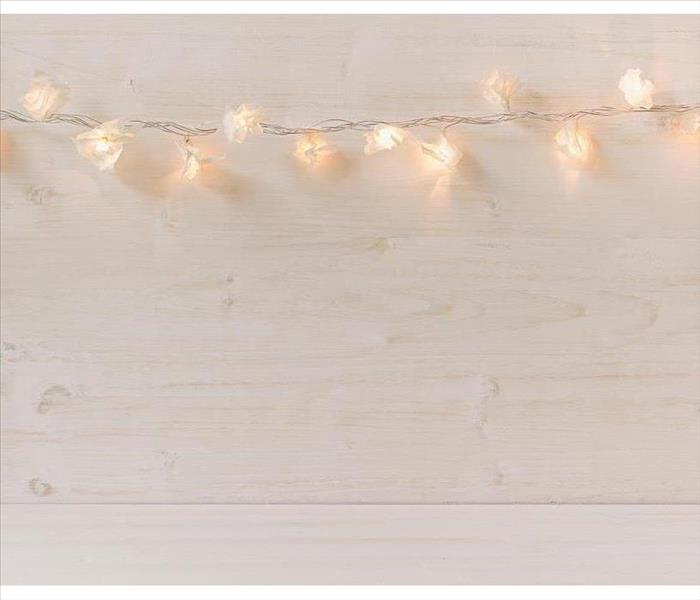 Fairy lights are another flameless solution
Fairy lights are another flameless solution
5 Alternatives to Candles To Keep Your Home Safe
Candles provide warm light and a refreshing scent in your home. They also pose a credible fire hazard. An unattended candle flame can contact a flammable object and create disastrous fire damage. Even though a fire restoration company can help you bring your home back, candle alternatives can prevent these incidents. Continue reading and consider some of the following options.
1. Oil and Wax Warmers
Warmers are safer solutions that deliver both light and a refreshing scent without an exposed flame. They usually have a small dish with either essential oils or wax. The device, powered by batteries or electricity, heats up the contents, providing aroma and illumination.
2. Electric Candles
If you value the light and aesthetic value that candles give, then you might appreciate electric candles. These items operate on batteries. They largely resemble actual candles and generate around the same amount of light, but they can be left alone with no candle fire risk.
3. Book Lights
When using light mainly for visual purposes like reading, book lights are the perfect candle alternatives. These devices come with clips so you can attach them inside books, near desks or on any convenient area. They give enough reading light without consuming too much energy or disturbing others.
4. Fairy Lights
Fairy lights are another flameless solution. These lights are powered by electricity or batteries and can be spread throughout the room to create relaxed, atmospheric lighting. Fairy lights can last for a long time and come in a variety of colors and shapes.
5. Stick Diffusers
There are several options if you are simply looking for an elegant scent for your home. Stick diffusers deliver a strong fragrance without using any power source. Sticks such as reed absorb the scented oil in the bottle and spread out the pleasant smell.
Though candles may provide both illumination and fragrance for your Hamilton Park, TX, home, there are plenty of safe candle alternatives. Using any of these items can prevent a candle fire from destroying your house.
The Truth About Cleaning Mold With Bleach
7/22/2019 (Permalink)
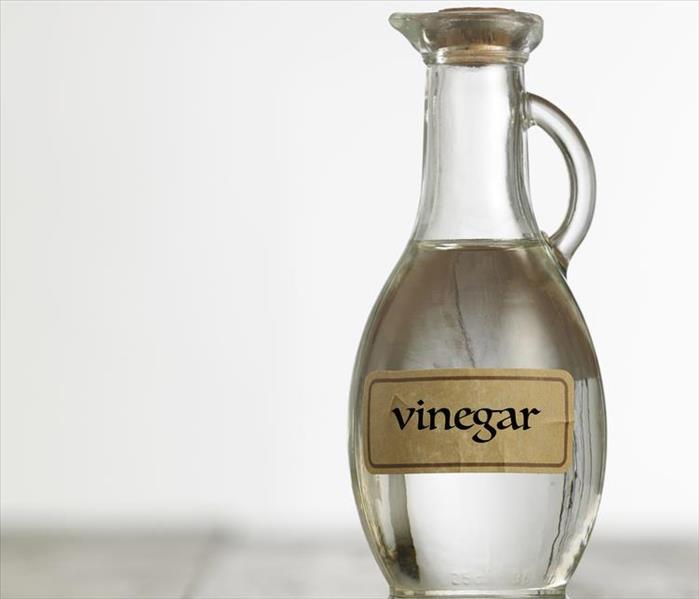 Apply vinegar to the mold
Apply vinegar to the mold
When it comes to the correct way to handle a fungus cleanup job, there are many misconceptions people have that can lead to an inadequate cleaning job and an even larger mold problem. One common error people make when cleaning mold is using bleach on the affected surface believing that it is effective at killing mold. Here is some information on why you should never pull out this chemical when removing fungus and how to correctly handle mold growth in your business.
Can I Clean Mold on My Own?
If you have found mold growing in your business in Oak Tree Village, TX, you will need to first determine if the fungus cleanup job is small enough to handle on your own or if you will need the help of a mold damage cleanup company. If mold has just been found in a small, concentrated area, the following methods can be effective:
- Spray area with hydrogen peroxide
- Apply vinegar to the mold
- Scrub surfaces with a baking soda solution
It is important to remember that a mold problem can often be worse than it looks. While keeping humidity levels low, addressing leaks, and cleaning up spills can help prevent mold from growing, if a problem does exist it’s often best to call in the professionals to cleanup mold.
Does Bleach Kill Mold?
While bleach is effective for addressing a variety of cleaning needs, getting rid of mold is not one of them. This chemical is not very effective at killing mold and loses its effectiveness over time. Additionally, it can only address mold on the area’s surface and will not get rid of any fungus that has made its way into a porous material, such as wood.
While no one wants to find mold growing in their business, proper fungus cleanup can stop mold in its tracks and prevent the problem from getting worse. Just make sure to leave ineffective chemicals in the cabinet, and don’t hesitate to call in the professionals.
4 Tips to Prevent Candle Fires
7/16/2019 (Permalink)
 Battery powered candle
Battery powered candle
Help Prevent a Candle Fire in Your Home
Candles are a popular way to decorate your home. Unfortunately, they are also a common cause of fires. Use the following safety tips to help prevent a candle fire from starting in your Wilshire Heights, TX, house.
1. Do Not Leave Candles Unattended
The first thing to remember is that you should never leave a candle unattended. Whether you are leaving the house, going to bed or simply moving to a different room, you should always extinguish any lit candles first. This is especially true in homes with pets or small children who may knock them over unintentionally.
2. Place Candles in a Safe Location
When using candles, make sure that they are placed away from anything that could start a candle fire. Do not use them near flammable liquids or materials that may catch fire, such as curtains or bedding. Papers and books should be kept at a safe distance as well.
3. Use Appropriate Holders
While it is a good idea to place a candle in a holder rather than directly on the surface underneath, you should be sure that you are using one that is designed for this purpose. Some containers may not be resistant to heat and can melt or break when they become too hot. If this happens, a fire is likely to start.
4. Use an Alternative
Of course, the easiest way to prevent a candle fire is by not using candles at all. While they can contribute to a pleasant atmosphere, they do pose a safety risk. Fortunately, there are now a large number of products that mimic a candle’s properties. You can find battery-operated lights that give off a warm, flickering glow and provide a pleasant scent, similar to that of a candle.
Keeping these tips in mind can help you use candles more safely. However, in case you do experience a fire, it's a good idea to have the contact number of a local fire restoration company on hand. These professionals can help with everything from smoke cleanup to structural repairs.
5 Steps To Take If You Smell Gas in Your Home
5/15/2019 (Permalink)
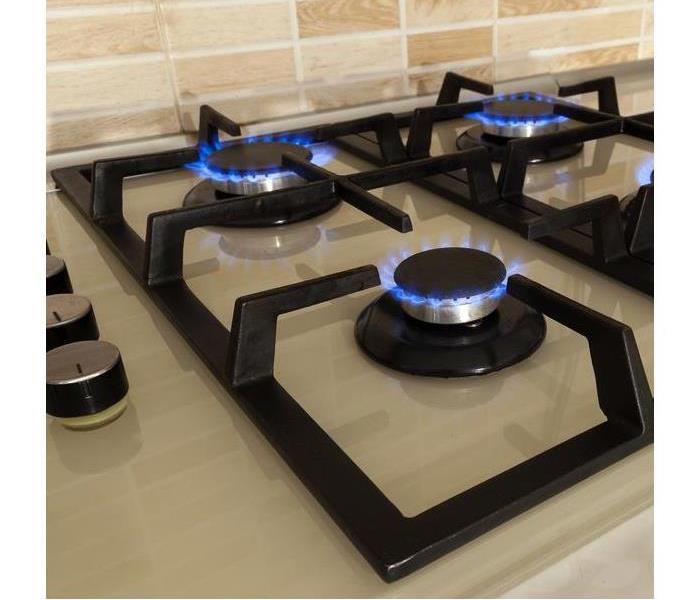 If a gas fire does start, a fire damage restoration specialist can help restore your home
If a gas fire does start, a fire damage restoration specialist can help restore your home
Five Steps to Avoid a Gas Explosion in Your Home
If a strong odor is lingering in your home that smells similar to rotten eggs or sulfur, it is possible you have a gas leak. You might also hear a faint hissing noise. While natural gas is not toxic to breathe in, leaking gas is extremely flammable and is considered an immediate emergency. If you smell gas in your home, quickly take these five steps to avoid a gas explosion and keep your family safe.
1. Turn Off the Stove
Often, a suspected gas leak is actually the smell of gas from the stove that someone accidentally turned on. If that’s the case, quickly turn off the stove. Is the stove is not the source of the smell, make sure the oven and stove are both turned off regardless to prevent a gas fire.
2. Put Out Any Open Flames
If you smell a gas leak, never use a lighter or ignite any kind of flame. If any candles are lit or the fireplace is on, quickly extinguish the flames.
3. Keep Lights and Electronics Off
As soon as you detect the smell of natural gas in your home, refrain from turning on any lights or electronics which can start a gas fire. Grab a flashlight if necessary.
4. Open Doors and Windows
Allow gas to quickly escape your home by opening all the windows and doors. You can turn on the oven range hood fan to help remove some of the gas.
5. Evacuate Your Home
As soon as you feel it is unsafe to remain in your home, quickly get everyone, including pets, out of your home. Once you make it across the street from your home call 9-1-1.
Keeping your family safe and escaping your home should always be your priority if you smell a gas leak. If a gas fire does start, a fire damage restoration specialist can help restore your home back to its pre-fire condition.
Five Safety Tips to Prevent a Dryer Fire
2/5/2019 (Permalink)
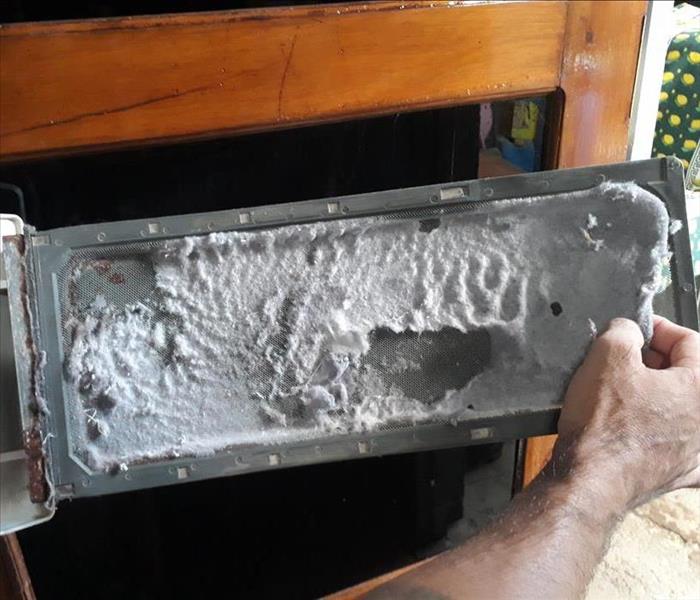 Clean the lint filter of your dryer regularly
Clean the lint filter of your dryer regularly
Five Safety Tips to Prevent a Dryer Fire
A clothes dryer is a common and convenient household appliance, but it can be dangerous if not properly maintained. Not only can the dryer break and need replacing, but it can also cause a lint fire in your Dallas, TX home. Follow these safety tips to help prevent any emergency situations.
1. Have Your Dryer Professionally Installed
Having your dryer installed by a qualified professional can put you on the right path to keeping your home safe. They can make sure that everything is installed correctly and working as it should, preventing any potential safety hazards.
2. Clean the Lint Filter and Dryer Vent Regularly
The most common cause of a dryer fire is not keeping the unit clean. You should remove lint from the filter before and after each use. Lint can also build up in the back of the dryer, so be sure to clean that area as well. The dryer vent should be cleaned at least every three months to prevent blockages.
3. Have the Dryer Serviced Regularly.
It is a good idea to have your dryer serviced on a regular basis. Hiring a professional to clean and inspect the appliance at least once a year can help minimize any problems and keep the unit safe to use.
4. Keep Flammable Items Away From the Dryer
A lint fire is not the only kind of fire that can occur when using your dryer. If a flammable liquid has been spilled on an item, you should never put it in the dryer. Be sure to keep any flammable materials away from the surrounding area as well.
5. Make Sure the Dryer is Off Before You Leave the House
If you are leaving your house or going to sleep, make sure that you turn the dryer off beforehand. If a fire were to start while the unit was unattended, it could spread and cause a lot of damage before you were aware of it.
You can hire fire remediation specialists to help in case of a lint fire, but keeping your dryer cleaned and properly maintained can help keep your unit safe.
What are the dangers of space heaters?
6/20/2018 (Permalink)
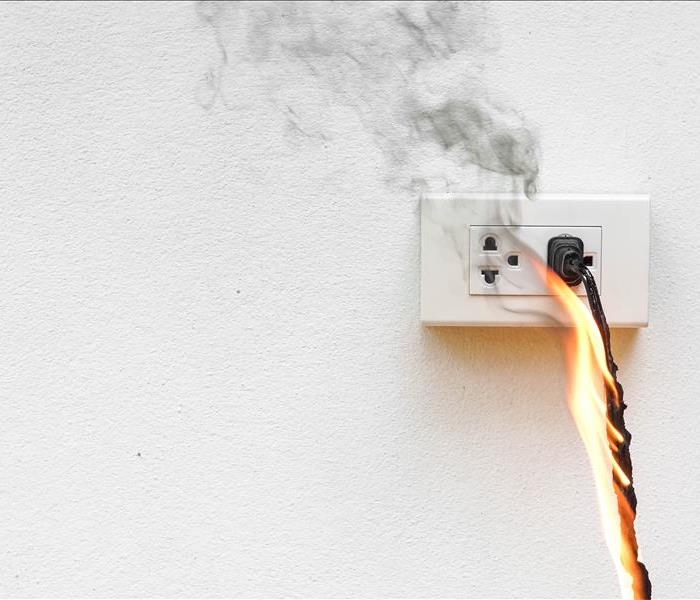 Chord burning while plugged into a wall.
Chord burning while plugged into a wall.
Fire Hazards for Electric Heaters
SAFETY TIPS
CPSC recommends the following for the safe use of electric heaters:
- Never operate a heater you suspect is damaged.
- Before use, inspect the heater, cord, and plug for damage.
- Follow all operation and maintenance instructions.
Visit www.SaferProducts.gov to see if your electric heater has been recalled.
- Never leave the heater operating while unattended, or while you are sleeping.
- Keep combustible material such as beds, sofas, curtains, papers, and clothes at least 3 feet (0.9 m) from the front, sides, and rear of the heater.
- Be sure the heater plug fits tightly into the wall outlet. If not, do not use the outlet to power the heater.
- During use, check frequently to determine if the heater plug or cord, wall outlet, or faceplate is HOT! If the plug, outlet, or faceplate is hot, discontinue use of the heater, and have a qualified electrician check and/or replace the plug or faulty wall outlet(s). If the cord is hot, disconnect the heater, and have it inspected/repaired by an authorized repair person.
- Never power the heater with an extension cord or power strip.
- Insure that the heater is placed on a stable, level surface, and located where it will not be knocked over. Never run the heater’s cord under rugs or carpeting. This can damage the cord, causing it and nearby objects to burn.
- Prevent electrical shocks and electrocutions, always keep electric heaters away from water, and NEVER touch an electric heater if you are wet
Holiday Care to Reduce Fire Risk
11/26/2017 (Permalink)
Most Homeowners are aware that holiday decorations should be used with care. Each year, statistics tell the story of fire danger resulting from frayed wires, proximity to heat sources, and left on unattended. But, SERVPRO of Northeast Dallas wants homeowners to know that the danger of fire caused by holiday decorating, and by Christmas trees specifically, actually increase after the holiday. Research from the National Fire Protection Association (NFPA) says while four out of five Christmas tree fire happen in December and January, the 10 days with the highest average number of fires were all after Christmas Day.
For many families, preparing for the holiday season is a very busy time. Come December 26, it is tempting to relax and stop watering the tree, replacing bulbs in outdoor lights and tucking indoor garlands back into place. Dry greens, open sockets and decorations that slip dangerously close to light sockets or fireplaces can all increase the risk of fire in the days after the Christmas holiday.
The American Christmas Tree Association quotes Nielsen research that says Americans purchased 21.06 million live Christmas trees in 2011. That number is significant because according to the NFPA, Christmas trees remain the number one culprit in holiday fires. Forty – three percent of Christmas tree fires happen in December, but January is close behind, claiming 39 percent – numbers that demonstrate the danger of allowing Christmas trees to dry out during and after the holiday season.
As the holiday season moves into full swing, SERVPRO of Northeast Dallas reminds homeowners to take common sense precautions based on a clear understanding of the potential danger to help prevent holiday tradition from turning into a holiday nightmare.

 24/7 Emergency Service
24/7 Emergency Service






















